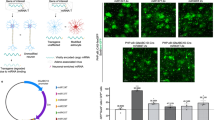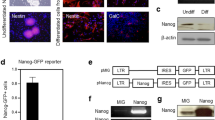Abstract
Selective gene expression in neurons is still a challenge. We have developed several expression vectors using a combination of neuron restrictive silencer elements (NRSEs), hypoxia responsive elements (HREs) and CMV minimal promoter (CMVmp). These elements were packaged into replication defective adenovirus to target gene expression selectively in neurons in a hypoxia-regulated manner. Neuronal selectivity and responsiveness to hypoxia of these novel constructs were determined empirically in both neural cell lines and primary cerebellar granule neurons (CGNs). The construct p5HRE-3NRSE exhibited not only the highest level of reporter gene expression in neuronal cells but also in an oxygen concentration-dependent manner when compared with all other constructs. As expected, this construct did not elicit reporter gene expression in non-neuronal cells including human HEK293A and HT29 cells, rat NRK cells, mouse 3T6 cells and 3T3 L1 cells. This construct was packaged into a replication defective adenoviral vector (Ad/5HRE-3NRSE) to determine neuron-selective and hypoxia-inducible gene expression in cultured mouse postmitotic primary CGNs and differentiated human NT2 neurons (NT2/Ns). Remarkably, in response to hypoxia, Ad/5HRE-3NRSE showed strong hypoxia-inducible gene expression selectively in neurons (12-fold induction in CGNs and 22-fold in NT2/Ns), but not in glial cells. Taken together, this vector with restricted gene expression to neurons under the regulation of hypoxia will be a useful tool for investigations of mechanisms of neuronal damage caused by ischemic insult.
This is a preview of subscription content, access via your institution
Access options
Subscribe to this journal
Receive 12 print issues and online access
$259.00 per year
only $21.58 per issue
Buy this article
- Purchase on Springer Link
- Instant access to full article PDF
Prices may be subject to local taxes which are calculated during checkout





Similar content being viewed by others
References
Cavazzana-Calvo M, Thrasher A, Mavilio F . The future of gene therapy. Nature 2004; 427: 779–781.
Feng X, Eide FF, Jiang H, Reder AT . Adeno-associated viral vector-mediated apoe expression in Alzheimer's disease mice: low CNS immune response, long-term expression, and astrocyte specificity. Front Biosci 2004; 9: 1540–1546.
Barkats M et al. Adenovirus in the brain: recent advances of gene therapy for neurodegenerative diseases. Prog Neurobiol 1998; 55: 333–341.
Horellou P, Sabate O, Buc-Caron MH, Mallet J . Adenovirus-mediated gene transfer to the central nervous system for Parkinson's disease. Exp Neurol 1997; 144: 131–138.
Benihoud K, Yeh P, Perricaudet M . Adenovirus vectors for gene delivery. Curr Opin Biotechnol 1999; 10: 440–447.
Baekelandt V, De Strooper B, Nuttin B, Debyser Z . Gene therapeutic strategies for neurodegenerative diseases. Curr Opin Mol Ther 2000; 2: 540–554.
Nadeau I, Kamen A . Production of adenovirus vector for gene therapy. Biotechnol Adv 2003; 20: 475–489.
Masumu M, Hata R . Recent advances in adenovirus-mediated gene therapy for cerebral ischemia. Curr Gene Ther 2003; 3: 43–48.
Xu D et al. Attenuation of ischemia-induced cellular and behavioral deficits by X chromosome-linked inhibitor of apoptosis protein overexpression in the rat hippocampus. J Neurosci 1999; 19: 5026–5033.
Ferrer I, Planas AM . Signaling of cell death and cell survival following focal cerebral ischemia: life and death struggle in the penumbra. J Neuropathol Exp Neurol 2003; 62: 329–339.
Yenari MA et al. Gene therapy and hypothermia for stroke treatment. Ann NY Acad Sci 2003; 993: 54–68.
Sakurai M et al. Adenovirus-mediated glial cell line-derived neurotrophic factor gene delivery reduces motor neuron injury after transient spinal cord ischemia in rabbits. J Thorac Cardiovasc Surg 2000; 120: 1148–1157.
Abe K, Hayashi T . Expression of the glial cell line-derived neurotrophic factor gene in rat brain after transient MCA occlusion. Brain Res 1997; 776: 230–234.
Hou ST, MacManus JP . Molecular mechanisms of cerebral ischemia-induced neuronal death. Int Rev Cytol 2002; 221: 93–148.
Krasnykh VN, Douglas JT, van Beusechem VW . Genetic targeting of adenoviral vectors. Mol Ther 2000; 1: 391–405.
Ozawa CR et al. Neuroprotective potential of a viral vector system induced by a neurological insult. Proc Natl Acad Sci USA 2000; 97: 9270–9275.
Kugler S, Kilic E, Bahr M . Human synapsin 1 gene promoter confers highly neuron-specific long-term transgene expression from an adenoviral vector in the adult rat brain depending on the transduced area. Gene Therapy 2003; 10: 337–347.
Li L, Suzuki T, Mori N, Greengard P . Identification of a functional silencer element involved in neuron-specific expression of the synapsin I gene. Proc Natl Acad Sci USA 1993; 90: 1460–1464.
Schoch S, Cibelli G, Thiel G . Neuron-specific gene expression of synapsin. I. Major role of a negative regulatory mechanism. J Biol Chem 1996; 271: 3317–3323.
Jakobsson J et al. Targeted transgene expression in rat brain using lentiviral vectors. J Neurosci Res 2003; 73: 876–885.
Twyman RM, Jones EA . The regulation of neuron-specific gene expression in the mammalian nervous system. J Neurogenet 1995; 10: 67–101.
Twyman RM, Jones EA . Sequences in the proximal 5′ flanking region of the rat neuron-specific enolase (NSE) gene are sufficient for cell type-specific reporter gene expression. J Mol Neurosci 1997; 8: 63–73.
Gloster A et al. The T alpha 1 alpha-tubulin promoter specifies gene expression as a function of neuronal growth and regeneration in transgenic mice. J Neurosci 1994; 14: 7319–7330.
Mori N et al. A cell type-preferred silencer element that controls the neural-specific expression of the SCG10 gene. Neuron 1990; 4: 583–594.
Mori N et al. A common silencer element in the SCG10 and type II Na+ channel genes binds a factor present in nonneuronal cells but not in neuronal cells. Neuron 1992; 9: 45–54.
Schoenherr CJ, Anderson DJ . The neuron-restrictive silencer factor (NRSF): a coordinate repressor of multiple neuron-specific genes. Science 1995; 267: 1360–1363.
Tabuchi A et al. REST4-mediated modulation of REST/NRSF-silencing function during BDNF gene promoter activation. Biochem Biophys Res Commun 2002; 290: 415–420.
Wood IC et al. Interaction of the repressor element 1-silencing transcription factor (REST) with target genes. J Mol Biol 2003; 334: 863–874.
Wood IC, Roopra A, Buckley NJ . Neural specific expression of the m4 muscarinic acetylcholine receptor gene is mediated by a RE1/NRSE-type silencing element. J Biol Chem 1996; 271: 14221–14225.
Navarro V et al. Efficient gene transfer and long-term expression in neurons using a recombinant adenovirus with a neuron-specific promoter. Gene Therapy 1999; 6: 1884–1892.
Millecamps S et al. Neuron-restrictive silencer elements mediate neuron specificity of adenoviral gene expression. Nat Biotechnol 1999; 17: 865–869.
Binley K et al. An adenoviral vector regulated by hypoxia for the treatment of ischaemic disease and cancer. Gene Therapy 1999; 6: 1721–1727.
Binley K, Kan O, White J, Naylor S . Exploiting the hypoxia response. Curr Opin Mol Ther 2003; 5: 650–656.
Semenza GL . Targeting HIF-1 for cancer therapy. Nat Rev Cancer 2003; 3: 721–732.
Sharp FR, Bergeron M, Bernaudin M . Hypoxia-inducible factor in brain. Adv Exp Med Biol 2001; 502: 273–291.
Bergeron M et al. Induction of hypoxia-inducible factor-1 (HIF-1) and its target genes following focal ischaemia in rat brain. Eur J Neurosci 1999; 11: 4159–4170.
Semenza GL . HIF-1 and mechanisms of hypoxia sensing. Curr Opin Cell Biol 2001; 13: 167–171.
Wenger RH . Cellular adaptation to hypoxia: O2-sensing protein hydroxylases, hypoxia-inducible transcription factors, and O2-regulated gene expression. FASEB J 2002; 16: 1151–1162.
Su H, Arakawa-Hoyt J, Kan YW . Adeno-associated viral vector-mediated hypoxia response element-regulated gene expression in mouse ischemic heart model. Proc Natl Acad Sci USA 2002; 99: 9480–9485.
Shibata T, Giaccia AJ, Brown JM . Hypoxia-inducible regulation of a prodrug-activating enzyme for tumor-specific gene therapy. Neoplasia 2002; 4: 40–48.
Post DE, Van Meir EG . Generation of bidirectional hypoxia/HIF-responsive expression vectors to target gene expression to hypoxic cells. Gene Therapy 2001; 8: 1801–1807.
Shibata T, Giaccia AJ, Brown JM . Development of a hypoxia-responsive vector for tumor-specific gene therapy. Gene Therapy 2000; 7: 493–498.
Garcia-Sanchez R et al. Identification of repressor element 1 in cytochrome P450 genes and their negative regulation by RE1 silencing transcription factor/neuron-restrictive silencer factor. Biochim Biophys Acta 2003; 1620: 39–46.
Cao YJ, Shibata T, Rainov NG . Hypoxia-inducible transgene expression in differentiated human NT2N neurons – a cell culture model for gene therapy of postischemic neuronal loss. Gene Therapy 2001; 8: 1357–1362.
Cao YJ, Shibata T, Rainov NG . Liposome-mediated transfer of the bcl-2 gene results in neuroprotection after in vivo transient focal cerebral ischemia in an animal model. Gene Therapy 2002; 9: 415–419.
Koshikawa N, Iyozumi A, Gassmann M, Takenaga K . Constitutive upregulation of hypoxia-inducible factor-1alpha mRNA occurring in highly metastatic lung carcinoma cells leads to vascular endothelial growth factor overexpression upon hypoxic exposure. Oncogene 2003; 22: 6717–6724.
Koshikawa N et al. Therapeutic efficacy of the suicide gene driven by the promoter of vascular endothelial growth factor gene against hypoxic tumor cells. Cancer Res 2000; 60: 2936–2941.
Onteniente B, Rasika S, Benchoua A, Guegan C . Molecular pathways in cerebral ischemia: cues to novel therapeutic strategies. Mol Neurobiol 2003; 27: 33–72.
Hou ST et al. Activation of the Rb/E2F1 pathway by the nonproliferative p38 MAPK during Fas (APO1/CD95)-mediated neuronal apoptosis. J Biol Chem 2002; 277: 48764–48770.
Smith RA, Walker T, Xie X, Hou ST . Involvement of the transcription factor E2F1/Rb in kainic acid-induced death of murine cerebellar granule cells. Brain Res Mol Brain Res 2003; 116: 70–79.
Hou ST et al. The transcription factor E2F1 modulates apoptosis of neurons. J Neurochem 2000; 75: 91–100.
Hou ST et al. Increases in DNA lesions and the DNA damage indicator Gadd45 following transient cerebral ischemia. Biochem Cell Biol 1997; 75: 383–392.
Trojanowski JQ et al. Transfectable and transplantable postmitotic human neurons: a potential ‘platform’ for gene therapy of nervous system diseases. Exp Neurol 1997; 144: 92–97.
Nelson PT . Clonal human (hNT) neuron grafts for stroke therapy: neuropathology in a patient 27 months after implantation. Am J Pathol 2002; 160: 1201–1206.
Huang D et al. Characterization of the expression of key adenoviral receptors CAR and integrin β3/β5 subunits on the membrane of human NT2 neurons. J Mol Neurosci 2004; 24: 217–222.
Acknowledgements
We thank Drs JP MacManus and B Massie for stimulating discussions and Ms T Walker and E Twomey for their excellent technical support.
Author information
Authors and Affiliations
Rights and permissions
About this article
Cite this article
Huang, D., Desbois, A. & Hou, S. A novel adenoviral vector which mediates hypoxia-inducible gene expression selectively in neurons. Gene Ther 12, 1369–1376 (2005). https://doi.org/10.1038/sj.gt.3302538
Received:
Accepted:
Published:
Issue Date:
DOI: https://doi.org/10.1038/sj.gt.3302538
Keywords
This article is cited by
-
Evaluation of helper-dependent canine adenovirus vectors in a 3D human CNS model
Gene Therapy (2016)
-
Semaphorin3A elevates vascular permeability and contributes to cerebral ischemia-induced brain damage
Scientific Reports (2015)
-
Gene expression and gene therapy imaging
European Radiology (2007)



